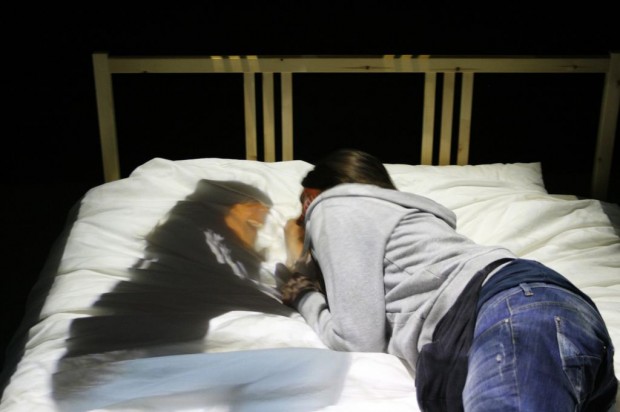
Telematic dreaming is interactive installation by Paul Sermon. In this work, people can communicate with the projected image of other people who are in separate place. Audiences and performers make collaborative movement through the video screen and projector. They pay a lot of attention to synchronize their movement and to communicate correctly like they could touch each other. It is clear that the projected image is not a real and just a flat, light image. Even though there is nothing physically, people give some space to image. We all know that the image on the bed is not a real person, but still people act like an image is a real. What makes it real?
In my opinion, ‘real’ is an empty image. If some clues satisfy the sense of real to some extent, people could make a real in their own way. In short, ‘real’ is replaceable. Therefore it is an empty image that we could fill it with temporary reality.
We will have to accommodate notions of uncertainty, chaos, autopoiesis and contingency to a view of the world in which the observer and observed, creator and viewer are inextricably linked in the process of making reality – all our many separate realities interacting, colliding, reforming, and resonating within the telematic noosphere of the planet.
-Roy Ascott, “Is There Love in the Telematic Embrace,” 1991, Multimedia: From Wagner to Virtual Reality
In this perspective, Telematic Dreaming captures the way we perceive something as a real. It suggests participators to collaborate with others to make a reality using their body. By doing so, they can connect and communicate with others who are at a distance, as they really meet face to face.
Telematic art reminds me of a television live program that was produced in 1983 in South Korea. It was the search campaigns for families separated by Korean war. This program lasted total 138days, from 22:15 pm, June 30 to 4:00 am, November 14 in 1983. The total live broadcasting time was 453hours 45minutes. Through this program, 100,952 application were submitted, 53,536 stories were introduced and 10,189 separated families were reunited. This broadcasting program triggered the official exchange visits of separated families from North Korea and South Korea. This event was the representative example that shows the social impact and possibility of telematics and television in South Korea.


I am intrigued by your analysis of Telematic Dreaming, in which you point out the construction of something real out of an interaction that takes place within the virtual. I actually see some interesting connections with Richard Wagner, who in his stage productions of opera constructs a spectacle that becomes “real” in front of the viewers’ eyes through the techniques of stagecraft and theater. This sense of the “real” we have discussed as the “suspension of disbelief,” in which we know something is not real, but we allow ourselves to “fill in the image” as you say to believe it is real. This is an excellent observation you have made and we’ll definitely want to discuss it further in class tonight when we have Paul Sermon as our guest speaker.